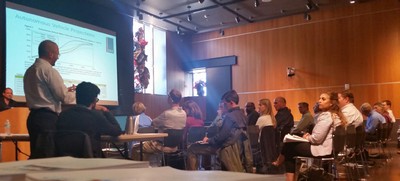RTC Hosts Workshop on Smart Transportation
More than forty people from around the bi-state region attended a workshop on smart transportation at the Fort Vancouver Regional Library on October 1. The half-day workshop was split into two sessions.
 The first was about connected vehicles, their future growth, applications, and impacts. The second session, on regional traffic signals, had presentations and discussion about central signal systems, traffic controllers, and options for shared systems.
The first was about connected vehicles, their future growth, applications, and impacts. The second session, on regional traffic signals, had presentations and discussion about central signal systems, traffic controllers, and options for shared systems.
The connected and autonomous vehicle (CAV) session began with a primer about CAVs. While connected vehicles communicate with other vehicles or roadway devices, they are not necessarily autonomous, or self-driving. Autonomous vehicles are also connected and are more associated with the self-driving cars being tested by Google.
A presentation was offered on what the emergence of CAVs means for public agencies. It included discussion of what traffic engineers need to do to “future proof” their signal controllers and roadway infrastructure. Another presentation described the questions transportation planners need to consider as the CAVs become a greater part of the vehicle fleet: What will be the impact on travel, safety, and road capacity? How will it affect commercial vehicles? How will capital investment assumptions in long range plans be affected?
There were also a couple of great videos illustrating the promise of CAVs. One, by the US Department of Transportation, focused on the transportation applications of CAVs.
The second, by AT&T, was about the commercial applications.
Attendees agreed that while it is too early to know the answers to these questions, now is the time to discuss, do the research, and incorporate these issues into the planning process.
The second session, about signal systems, had a series of presentations. The first provided an overview on central signal systems in general, with a short history leading to the current central systems in used in the Vancouver region. It described the recent decision between Clark County and the Southwest Region of the WSDOT to have a single shared central signal system. There were examples presented, of regions on the west coast and in the Portland region, where agencies have partnered to implement a shared central signal system in order to better facilitate traffic management and share costs.
The last part of the session was a roundtable discussion on how a shared model might apply to transportation agencies in Clark County. The discussion revolved around the opportunities and the potential constraints to moving toward a shared system, but was also productive, in that attendees recognized that the question should be explored further. Everyone agreed that a traffic operations work group should be convened to talk more about central signal systems and the future of signal controller technology.

